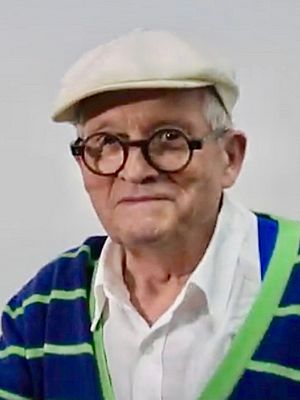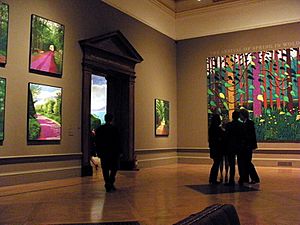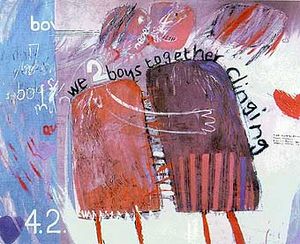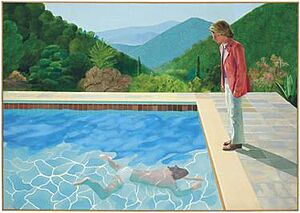David Hockney facts for kids
Quick facts for kids
David Hockney
|
|
|---|---|

Hockney in 2017
|
|
| Born | 9 July 1937 Bradford, West Riding of Yorkshire, England
|
| Education |
|
| Known for |
|
|
Notable work
|
|
| Movement | Pop art |
| Awards |
|
David Hockney (born 9 July 1937) is a famous English artist. He is known for his paintings, drawings, and prints. He also works as a stage designer and photographer. Hockney was an important artist in the Pop art movement of the 1960s. Many people consider him one of the most important British artists of the last 100 years.
Hockney has lived and worked in different places. He has homes and studios in Bridlington and London, England. He also has lived in California, USA, since 1964. His art often shows the places he has lived.
In November 2018, one of Hockney's paintings, Portrait of an Artist (Pool with Two Figures), sold for a very high price. It was sold for $90 million (£70 million) at an auction in New York City. At that time, it was the most expensive artwork ever sold by a living artist. This record was later broken by another artist, Jeff Koons.
Contents
Early Life and Art School
David Hockney was born in Bradford, England. He was the fourth of five children. His father was an accountant, and his mother was a very religious and strict vegetarian. During World War II, his father chose not to fight in the war.
Hockney went to art schools in Bradford and then in London. At the Royal College of Art in London, he met other artists. He was part of an exhibition called New Contemporaries. This show helped introduce the British Pop art movement. Hockney's early art had some elements similar to Expressionism.
When he was about to graduate, the Royal College of Art wanted him to complete a specific drawing assignment. Hockney refused, saying his art should be judged on its own. He painted Life Painting for a Diploma as a protest. The college recognized his talent and changed its rules. They gave him his diploma. After art school, he taught art at several universities in England and the United States.
Artistic Journey and Homes
In 1964, Hockney moved to Los Angeles, California. He was inspired by the sunny weather and swimming pools there. He started painting bright, colorful pictures of swimming pools using acrylic paints. For many years, he lived in Los Angeles, London, and Paris.
In 1974, he started a long-term friendship and working relationship with Gregory Evans. Gregory moved to the US with Hockney in 1976. He is still Hockney's business partner today.
Hockney bought a house in the Hollywood Hills in 1978. He made it bigger to include his art studio. He also owned a beach house in Malibu for many years. In the 1990s, Hockney started visiting his home county of Yorkshire in England more often. His friend, Jonathan Silver, encouraged him to paint the local scenery. Hockney began painting the Yorkshire countryside, often working outdoors.
He later made his home and studio in Bridlington, a seaside town in Yorkshire. He created large paintings made from many smaller canvases joined together. This helped him work on very big pictures. During the COVID-19 pandemic in 2020, he stayed and painted in a farmhouse in Normandy, France.
Hockney's Creative Works
Hockney has tried many different ways to make art. He has used painting, drawing, printmaking, and photography. He has also experimented with fax machines, computer programs, and even iPad drawing apps. His art shows many different things. These include still lifes, landscapes, and portraits of his friends and dogs. He also designs sets for plays and operas.

Portraits and People
Hockney has painted portraits throughout his career. From 1968, he painted realistic portraits of friends, partners, and family. These paintings captured how his subjects looked very well. He often painted the same people many times. These included his family, his assistants, writers, and fashion designers like Celia Birtwell and Ossie Clark. His painting Mr and Mrs Clark and Percy (1970–71) is a famous example. He has also painted over 300 self-portraits.
Between 1999 and 2001, Hockney used an old device called a camera lucida. This tool helped him draw more than 200 portraits of friends, family, and himself.
In 2016, the Royal Academy of Arts showed his series called 82 Portraits and 1 Still-life. These paintings were started in 2013. Hockney called them "twenty-hour exposures" because each person sat for him for many hours over several days.
Making Prints
Hockney started making prints early in his career. He made a lithograph self-portrait in 1954. In 1965, he created The Hollywood Collection, a series of lithographs. These prints showed imagined artworks inside frames. He also made many other print series. These included Friends, The Weather Series, and Some New Prints.
In the 1960s, he made print series that told stories. These included A Rake's Progress (1961–63) and Illustrations for Six Fairy Tales from the Brothers Grimm (1969).
In 1973, Hockney began working with Aldo Crommelynck, a famous printer. They created many etchings together. One important series was The Blue Guitar (1976–77). This series of 20 etchings was inspired by a poem by Wallace Stevens and the artist Pablo Picasso.
In 1978, Hockney tried a new technique with liquid paper. He painted with paper pulp, making each artwork unique. He created 29 pieces, including sunflowers and swimming pools, using this method.
Photocollages and "Joiners"
In the early 1980s, Hockney started making photo collages. He called them "joiners." He used many Polaroid or 35 mm photos of the same subject. He then arranged them together to create one large picture. Because the photos were taken from different angles and times, the final image looked a bit like Cubism. Hockney wanted to show how human eyes see the world. Some of his "joiners" are landscapes, like Pearblossom Highway #2. Others are portraits, like My Mother, Bolton Abbey, 1982.
He discovered this idea by accident. He was working on a painting and took many Polaroid photos of a room. He glued them together and realized it created a story. It was like the viewer was moving through the room. He stopped painting for a while to focus on this new photo technique.
Hockney later realized that photography had limits. He said it was good for portraits but could not show space in landscapes as well as painting. He felt photography was "one-eyed." Because of these limits, he returned to painting.
Using New Technology
In 1985, Hockney used a computer called the Quantel Paintbox. This allowed him to draw directly on a screen. His work was shown in a BBC TV series. Later, in 2004, he started using a Wacom pad and pen with Photoshop to create digital drawings.
Since 2009, Hockney has used iPhone and iPad apps to create hundreds of portraits, still lifes, and landscapes. He often sent these digital drawings to his friends. In 2010 and 2011, he drew the landscape of Yosemite National Park on his iPad. He also used an iPad to design a stained glass window for Westminster Abbey. This window celebrates the reign of Queen Elizabeth II and shows a hawthorn blossom scene from Yorkshire.
From 2010 to 2014, Hockney made multi-camera movies. He used many cameras to record a single scene. He filmed the Yorkshire landscape, jugglers, and dancers. His earlier photo collages influenced this shift to digital photography. In 2014, he combined hundreds of photos to create "photographic drawings" of his friends. He continued this in 2017 using advanced software to combine thousands of photos. These were printed as huge photo murals and shown in art galleries.
Outdoor Landscapes
In June 2007, Hockney's largest painting, Bigger Trees Near Warter, was displayed at the Royal Academy in London. This huge painting is 15 by 40 feet (4.6 by 12.2 m) and shows a group of trees in Yorkshire. He painted it on 50 separate canvases, mostly working outdoors. In 2008, he gave this painting to the Tate in London. He said he wanted to give them something really good that would be there for a long time. A BBC documentary called David Hockney: A Bigger Picture (2009) showed him working on this painting.
Theatre Designs
Hockney's first stage designs were for a play in London in 1966. He then designed sets for operas like Stravinsky's The Rake's Progress in 1975 and The Magic Flute in 1978. In 1980, he designed sets and costumes for three French performances at the Metropolitan Opera in New York. These included a ballet called Parade and two operas.
He also designed sets for other operas, including Richard Wagner's Tristan und Isolde in 1987 and Puccini's Turandot in 1991. Hockney used models and computer systems to plan his stage designs. This allowed him to create very detailed sets. In 2017, he received an award from the San Francisco Opera for his work on Turandot. Many of his theatre designs are now part of The David Hockney Foundation's collection.
Art Exhibitions
David Hockney has had over 400 solo art shows and been in over 500 group shows. His first solo show was in 1963 when he was 26. By 1970, the Whitechapel Gallery in London held a big show of his past works. This show then traveled to other places in Europe.
In 2006, the National Portrait Gallery in London had a very large show of Hockney's portraits. It included 150 paintings, drawings, and photo collages from over 50 years. Hockney helped arrange the artworks. This exhibition was one of the gallery's most popular ever.

From January to April 2012, the Royal Academy in London presented A Bigger Picture. This show had over 150 works, mostly landscapes of his home county, Yorkshire. It included oil paintings, watercolours, and drawings made on an iPad. Hockney said the show was "about big things." Over 600,000 people visited this exhibition. It then traveled to museums in Bilbao, Spain, and Cologne, Germany.
From February to May 2017, the David Hockney exhibition at the Tate Britain became the most-visited show in the gallery's history. It celebrated Hockney's 80th birthday and showed his art from six decades. People liked that Hockney kept trying new technologies, like his iPad drawings. This popular show then went to Paris and New York.
In recent years, Hockney has shown new paintings on hexagonal canvases. He also displayed large 3D photographic drawings. In 2019, his early works were shown in his native Yorkshire at The Hepworth Wakefield.
Personal Life
Hockney has been open about his romantic relationships. In 1966, while teaching in California, he met Peter Schlesinger, an art student. Peter became a subject for many of Hockney's paintings and drawings. Another of Hockney's partners was Gregory Evans. They met in 1971 and started a relationship in 1974. While they are no longer romantically involved, they still work together. Gregory manages The David Hockney Studio. Hockney's current partner is Jean-Pierre Gonçalves de Lima, also known as JP, who is his chief assistant in the studio.
In March 2013, Hockney's assistant, Dominic Elliott, died at Hockney's studio in Bridlington. An investigation found it was an accidental death. In November 2015, Hockney sold his house in Bridlington.
He later moved to Normandy, France, and lived there until 2023. He then returned to London. Hockney has used hearing aids since 1979. He stays fit by swimming every morning and can stand for many hours while painting.
Hockney has a special ability called synesthesia. This means he connects sounds, colors, and shapes in his mind.
Art Collections
Many of Hockney's artworks are displayed at the 1853 Gallery in Salts Mill in Saltaire, near his hometown of Bradford. A large number of his works are also held by The David Hockney Foundation. His art can be found in many public and private collections around the world, including:
- Honolulu Museum of Art
- Museum of Fine Arts, Boston
- National Gallery of Australia, Canberra
- Art Institute of Chicago
- Museum of Fine Arts, Houston
- Louisiana Museum of Modern Art, Humlebæk, Denmark
- National Portrait Gallery, London
- Tate, U.K.
- J. Paul Getty Museum, Los Angeles
- Los Angeles County Museum of Art
- Walker Art Center, Minneapolis
- Metropolitan Museum of Art, New York
- Museum of Modern Art, New York
- Centre Georges Pompidou, Paris
- Fine Arts Museums of San Francisco
- Museum of Contemporary Art, Tokyo
- Aboa Vetus & Ars Nova, Turku, Finland
- Mumok, Ludwig Foundation, Vienna
- Hirshhorn Museum and Sculpture Garden, Washington, D.C.
- Smithsonian American Art Museum, Washington, D.C.
- Muscarelle Museum of Art, Williamsburg, VA
Awards and Recognition
In 1967, Hockney's painting Peter Getting Out of Nick's Pool won the John Moores Painting Prize. He was offered a knighthood in 1990 but turned it down. However, in January 2012, he accepted the Order of Merit. This is a special honor given to only 24 people at a time for their contributions to arts and sciences.
He has also received awards from the Royal Photographic Society. In 1997, he became a Member of the Order of the Companions of Honour. He is also a Royal Academician.
In 2003, Hockney received a Lifetime Career Award in Italy. In 2011, a poll of British artists named him Britain's most influential artist of all time. In 2012, Hockney was chosen by artist Sir Peter Blake to appear on a new version of the Beatles' Sgt. Pepper's Lonely Hearts Club Band album cover. This celebrated British cultural figures that Blake admired.
Art Market and Sales
Hockney's paintings have sold for very high prices. In 2006, his painting The Splash sold for £2.6 million. In February 2020, it sold again for £23.1 million.
His painting A Bigger Grand Canyon, made of 60 canvases, was bought by the National Gallery of Australia for $4.6 million.

Beverly Hills Housewife (1966–67) sold for $7.9 million in 2008. This set a new record price for a Hockney painting at the time. This record was broken again in 2016 when Woldgate Woods sold for £9.4 million. In 2018, Piscine de Medianoche sold for $11.74 million. Then, Pacific Coast Highway and Santa Monica sold for $28.5 million in the same auction.
As mentioned earlier, on November 15, 2018, David Hockney's 1972 painting Portrait of an Artist (Pool with Two Figures) sold for $90.3 million. This made it the most expensive artwork by a living artist sold at auction at that time. He had originally sold this painting for $20,000 in 1972.
In recent years, Hockney's iPad drawings have also become very popular in the art market. Their prices have increased significantly since they were first released.
The Hockney–Falco Idea
In a 2001 TV show and book called Secret Knowledge, Hockney suggested an interesting idea. He thought that old master painters used tools like the camera obscura and camera lucida. These tools could project an image of the subject onto the painting surface. Hockney believed this technique helped create the very realistic style of painting seen in the Renaissance and later art periods. He published his ideas in his book, which was updated in 2006.
Public Activities
Like his father, Hockney chose not to fight in the military. Instead, he worked as a medical orderly in hospitals from 1957 to 1959. David Hockney helped start the Museum of Contemporary Art, Los Angeles, in 1979. He also contributed to the political magazine Standpoint.
Hockney has spoken out about smoking. In 2005, he argued against banning smoking in public places. In 2013, he wrote a foreword for a book about smoking.
In October 2010, he and many other artists signed an open letter. They protested against cuts in funding for the arts.
The David Hockney Foundation
The David Hockney Foundation is a charity created by the artist in 2008. In 2012, Hockney gave many of his valuable paintings to the foundation. He also gave money to help it operate.
The foundation's main goal is to help people appreciate and understand visual art. It does this by showing, taking care of, and publishing David Hockney's work. Richard Benefield became the first executive director in 2017.
The foundation owns over 8,000 of Hockney's artworks. These include paintings, drawings, prints, and stage designs. They also have 203 of his sketchbooks and his personal photo albums. The foundation lends artworks to museums and exhibitions around the world. This includes shows like Happy Birthday, Mr. Hockney! at the Getty and his big shows in 2017–2018.
Images for kids
See also
 In Spanish: David Hockney para niños
In Spanish: David Hockney para niños




